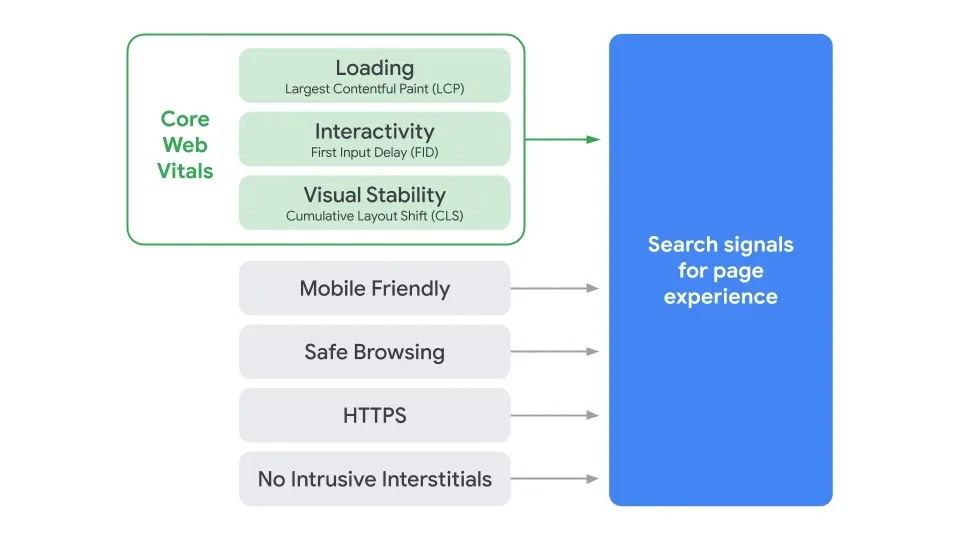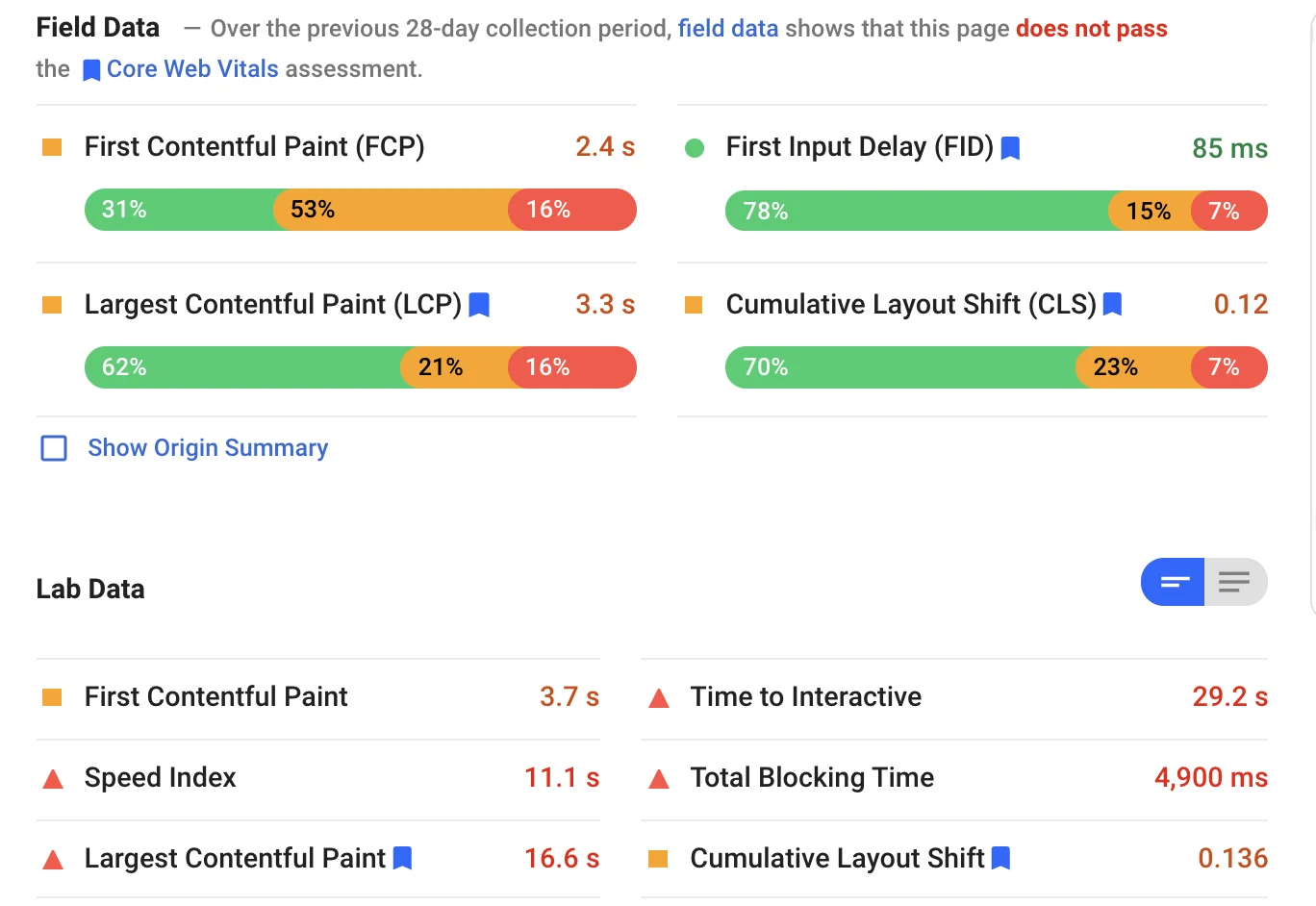The Ultimate Guide to Google’s 2021 Core Web Vitals
Shelley Kilpatrick

Google’s latest algorithm updates for page experience — primarily the much-talked about Core Web Vitals — will go into effect in May 2021. But if you’re not aware of what this means for SEO or your BigCommerce website, don’t worry — we’ve got you covered.
“Helping with conversion and improving page experience, including page load performance, has always been, and continues to be, a major focus for us,” advises Troy Cox, Vice President of Product Management at BigCommerce. “Google’s Core Web Vitals initiative makes it easy to quantify a page’s experience, and we’ve been working with Google for some time now to optimize the platform for these metrics.”
In this guide, we’ll review Google’s page experience signals, including Core Web Vitals, ways you can measure page experience and specific resources you can leverage to improve your SEO and website experience.
Google’s Seven Signals for Page Experience
According to Google, page experience is a set of signals that measure how users perceive the experience of interacting with a web page beyond its pure informational value. The idea behind page experience is to make your website the best it can be for users.
To make that happen, Google has shared seven search signals that you can focus on:
Mobile friendliness
Safe browsing
HTTPS/SSL, or encryption
Intrusive interstitials
Largest Contentful Paint (LCP)
First Input Delay (FID)
Cumulative Layout Shift (CLS)
While the first four items on the list have been around for years, the last three make up the new Core Web Vitals, which address loading speed, interactivity and visual stability.

“Google is looking for existing signals, like mobile-first design, safe browsing, HTTPS and intrusive interstitials, and except for that last one, BigCommerce does it all out-of-the-box for you,” explains Brian Miller, Client Development Executive at BigCommerce. “Our themes are mobile-friendly, we update our JavaScript libraries and we offer HTTPS site-wide.”
Something to keep in mind though is that each of these signals should be part of your overall SEO and customer experience strategy. Google made it clear that these changes will join the hundreds of signals they take into consideration when delivering search results.
So now that you know what each of the search signals are, let’s explore how they impact SEO and customer experience.
1. Mobile-friendly web pages.
Since the arrival of smartphones, mobile search has grown significantly. And anticipating the impact of smartphones, Google prioritized mobile-friendly websites in its search rankings back in 2015.
What mobile-friendly, or mobile-first, means is that it must be easy for users to complete a task, such as finding your return policy, directly from their phones. To make your ecommerce website mobile-friendly, you should choose a theme that supports responsive design, in which each element on the page automatically adapts to a user’s screen — no matter what device they’re using.
2. Safe browsing.
One of the page experience signals that Google has relied on is safe browsing. This means your website doesn’t have any malicious or deceptive content. For example, malware or social engineering content.
3. HTTPS/SSL.
This rankling factor boosts websites that adopt HTTPS, which provides users with a more secure browsing experience. BigCommerce offers a free Secure Sockets Layer (SSL) certificate for ecommerce stores on any plan, allowing you to enable site-wide HTTPS. If you’re not using BigCommerce, you can reach out to your domain provider to purchase a SSL.
4. No intrusive interstitials.
While no intrusive interstitials may sound complicated, it simply means don’t add elements to your website that make it hard for users to access content. For example, don’t show a pop-up that covers the main content on the page right when someone navigates to it from the search results.
However, there are some types of interstitials Google says are okay, such as banners for cookie usage or a full-screen blocker for age verification.
5. Largest Contentful Paint (LCP).
Slow loading websites have been a major pain point for users for years. Inevitably, you’ve abandoned a website before, simply because the page didn’t load fast enough. However, there’s never been a really effective way for website owners to measure the extremely complex metrics that encompass page loading speed.
“From an ecommerce perspective, this really it’s pretty fundamental to how you drive traffic to your site,” explains Jeremy Adam, Director of Web Strategy at BigCommerce. “Page load speed is a key thing that I think a lot of people are not paying enough attention to right now because it can be easy to ignore. However, you have to keep in mind that there’s a lot of people that have different devices and different internet connections.”
By looking at the Largest Contentful Paint (LCP), you can determine how long it takes the largest image or text block on your website to render. And according to Google, a good user experience means that LCP should occur within 2.5 seconds of when the page first starts loading.
6. First Input Delay (FID).
Once the content loads on a page, the next indication of a good experience is when you can start interacting with that content. This is where First Input Delay (FID) comes in to quantify responsiveness.
Jose Flores III, SEO Growth Coach at BigCommerce, elaborates, “Once the page starts loading, how soon can the user begin interacting with the site? For example, in video game terms, when you have a controller with a laggy input, it’s really frustrating, right? You want the user to start exploring your content right away with no delays.”
FID measures the time between when someone first interacts with the page to when the browser processes that interaction. For this metric, Google states that pages should have an FID of less than 100 milliseconds.
7. Cumulative Layout Shift (CLS).
“Let’s say you’re browsing a news site, and then, all of a sudden, several ads pop up. That’s something Google is really targeting with CLS because of how much it negatively impacts page experience,” shares Kevin Jones, SEO Manager at BigCommerce.
Cumulative Layout Shift (CLS) measures how often a web page moves when users are interacting with a site. Specifically, CLS accounts for the sum total of each unexpected layout shift, therefore emphasizing the importance of visual stability on the page. A good score for CLS, according to Google, is 0.1 or less.
“Specifically, the ways in which BigCommerce helps with Cumulative Layout Shift is that many of our themes use technologies like lazy loading with a low-res image preview that, for the most part, are designed to prioritize that initial view port,” states Flores.
One thing to keep in mind is that not all layout shifts are bad — only the unexpected ones. For instance, when someone starts typing in a search box or playing a video, they expect that some of the content on the page will change.
Now that we’ve reviewed each of the seven search signals and defined a good score for the Core Web Vitals, let’s dig into how you can measure them.
How to Measure Core Web Vitals
To help you better understand the areas that are most important, Google categorizes each Core Web Vital as poor (red), needs improvement (yellow) and good (green).
“These categories are a good indicator of how your web pages are performing. So for example, if you’re seeing several poor URLs, you’ll want to dig further into the issues to find out why the score is so low,” advises Jones.
Additionally, Google offers several solutions for measuring Core Web Vitals. For those with less technical experience, PageSpeed Insights provides a report on performance, as well as suggestions on how you can improve that page.

Another tool that should be part of your SEO arsenal is Google Search Console. In addition to providing data on search traffic, queries, clicks and referral sites, Google has now included a Core Web Vitals report. The report shows you URL performance grouped by status, metric type and URL group (groups of similar web pages).
For those with more technical experience, Google has several in-depth resources, including:
“In addition to utilizing Google’s tools, an agency can help merchants ensure their website meets the benchmarks for Google’s Core Web Vitals update by being transparent with the data they encounter, providing useful and relevant recommendations that will help their merchants’ websites improve, guiding merchants through the implementation process, and following up post-implementation to ensure everything is as buttoned up as possible,” adds Robyn Riley, Senior Technical Analyst at ROI Revolution.
For ecommerce businesses that sell internationally, you’ll also want to measure page load times for each region. As an example, let’s say you’re based in the United States, but you have a landing page targeting the United Kingdom.
You’ll want to understand page load time in the UK and ensure it’s as good as your US pages. This is especially important for regions like Australia where internet connection speeds can vary widely across the continent.
“Another tool for measuring regional load time is called Pingdom from SolarWinds,” explains Adam. “You can actually drop in a URL and select which server location to load it from. And it’s going to test it in those different regions.”
As for the timing of these changes, an update from Google in April of 2021 states that they will begin using page experience as part of their ranking systems beginning in mid-June 2021. But, page experience won’t play its full role until the end of August.
How to Prepare Your Online Store for the 2021 Core Web Vitals Update
For BigCommerce merchants, you already have a leg up when it comes to SEO optimization. Mobile-ready themes, Insights and Analytics tools, fields for page titles, meta descriptions and image alt texts and a content delivery network are all included. Plus, you can take advantage of them — even if you don’t have any coding experience.
Of course this doesn’t mean you don’t still need to be proactive about optimizing your site for page experience. In fact, it’s one of the things you have the most control over to make significant changes that will improve your rankings.
“We have made several platform updates on our side to maximize Core Web Vitals for merchants. Having said that, merchants also need to be aware and potentially do some things on their end,” states Cox. “For example, merchants have full control over their page content. They should be building page content in a way that maximizes the Core Vitals.”
However, making all these changes can be daunting for anyone, whether you’re running a small business or optimizing several ecommerce sites. To help, we’ve pulled together a list of resources for you.
1. Take advantage of BigCommerce University SEO coaching.
If you’re a BigCommerce merchant, you can take advantage of our SEO coaching and auditing services. Through virtual sessions, our coaches work with you to measure your traffic and SEO performance, and then provide recommendations on the specific improvements you can make.
“We’re here to educate you on how to be an expert,” adds Miller. “Our services are designed to be holistic and identify everything, from easy, quick updates merchants can make right away to opportunity gaps that merchants can address in their strategic business planning.”
With three different SEO packages available, merchants can choose the option that best fits their specific needs.
2. Explore BigCommerce Agency partners.
BigCommerce Agency partners are another great resource for merchants — or for anyone looking for additional SEO or developer support. Below is a short list; however, you can find even more Agency partners listed in our directory.
We even wrote a whole blog article with tips for choosing an SEO agency that can help ensure you’re picking the right partner to work with.
3. Look into getting new SEO tools.
In addition to Google Search Console and Google Analytics, you can also look into more robust tools that are specific for SEO. Here are some options that our team recommends:
Semrush offers a wide-range of features that encompass everything you need to track and analyze SEO, as well as content marketing, advertising and competitor research.
Moz dives deep into SEO with tools for keyword research, rank tracking and on-page optimization. Plus, they have tons of free content on their blog.
Ahrefs is an all-in-one SEO toolset that will audit your website, help you understand keywords, identify broken links, track your rankings and more.
4. Keep digging into Google’s documentation.
If you’re working on a limited budget, don’t worry. Google has a wealth of free resources for you to learn more about how you can optimize your website for search:
SEO Starter Guide: Get a complete overview of the basics of SEO according to Google’s best practices.
Advanced SEO Guide: Learn about advanced topics for managing and maintaining a website.
Google Search Channel: Watch videos that share information and tools that you can use to improve your site in Google Search.
Core Web Vitals: Dig into Google’s documentation for even more information about each of the Core Web Vitals and how they affect your ecommerce site.
5. Check out more resources from BigCommerce.
Did you know that BigCommerce has a robust Knowledge Base with several guides dedicated to SEO best practices? If not, feel free to check them out here:
We also continuously blog and create content around all things ecommerce and SEO. In fact, we’ve been writing about it for years. Check out some of our top SEO-focused blog posts:
Ecommerce SEO Guide: How Online Stores Can Drive Organic Traffic
The Top 10 SEO Myths: Don’t Fall Into These Often Repeated Traps
How to Build a B2B SEO Strategy That Will Put You Ahead of the Competition
Additionally, our team created a series of shorter webinars that address a wide-range of ecommerce topics. We recommend watching The Cardinal Rules of SEO and 4 Ways of Getting Traffic.
Two Easy Ecommerce Optimizations for Core Web Vitals
There’s a lot to dig into about Core Web Vitals and overall SEO best practices. But the deadline to comply is approaching quickly, so if you want to get started now, we’ve identified two easy things you can do.
1. Optimize and compress your images.
Between hero images, product pictures, carousels and banners, ecommerce websites have a lot of images. And for many ecommerce sites, images are the largest element that has to load, which can negatively impact your LCP metric.
“You have to think about how images are going to impact the page load speed,” advises Adam. “Even with a content delivery network, it’s always best practice to compress your images before you add them to your store.”
In addition to compressing your images, consider removing some of them if they aren’t relevant to the content on the page. And always make sure your images are in the most updated, web-friendly format, such as JPEG 2000, JPEG XR or WebP.
Also, if you have a custom theme on BigCommerce, make sure you’re taking advantage of our content delivery network, in addition to optimizing your images.
2. Evaluate your third-party tools.
Third-party tools and plug-ins are one of the biggest culprits when it comes to making your pages load slowly. While many of these tools provide much-needed functionality, you may also have some that you’ve never used or have stopped using.
“Audit the third-party tools and apps you’ve installed,” Adam recommends. “Consider finding ways to either reduce some of the code they load on your site, or just be aware of how much they are using. And if there’s an app you’re not using, remove it.”
Some of the third-party code and tools that Google suggests looking into first include:
Social sharing buttons
Video player embeds
Chat services
Advertising iframes
Analytics and metrics scripts
A/B testing scripts for experiments
Google also advises not to use the same functionality from two different vendors. For instance, you probably don’t need two tag managers or two A/B testing tools.
Wrapping Up
We hope this guide gives you the headstart you need to better understand Google’s Core Web Vitals and all the other elements of page experience. At the end of the day, Google just wants what we all do — better website experiences for everyone. So as long as you continue to focus on creating quality content that adds value to your customers, you’ll be in good shape.

Shelley Kilpatrick is an accomplished content marketer who creates compelling, original content designed to educate and empower ecommerce businesses. She is currently Manager of Content Marketing at BigCommerce where she leads a world-class team of content writers and strategists. Outside of work, she loves exploring all things Texas BBQ and craft beer with her husband and two dogs.